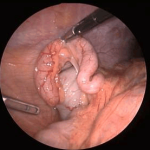PATIENT INFORMATION FOR LAPAROSCOPIC APPENDECTOMY [Removal of Appendix]
- What is an appendix?
- What is appendicitis, how does it occur?
- What are the symptoms?
- How is appendicitis treated?
- What is a laparoscopic appendectomy?
- Advantages of laparoscopic appendectomy
- What if operation cannot be performed by the laparoscopic method?
- What should I expect after surgery?
- What complications can occur?
- Can Laparoscopy be done in children also?
- Is it risky for people with other medical problems like Diabetes, Hypertension & Morbid Obesity?
- What are other procedures which can be done laparoscopically?
- The appendix is a small, finger like rudimentary pouch located where the large and small intestines join.
- Its functioning is unknown but it is hypothesized that appendix may produces immunoglobulin which helps fight infection in the body. Its function, however, is not essential.
- People who have had appendectomies (removal of appendix) do not have an increased risk towards infection.
What is appendicitis, how does it occur?
- Appendicitis is an inflammation of the appendix i.e. body’s reaction to irritation, injury or infection.
- Cause of appendicitis is usually unknown.
- In most cases it is caused by a blockage of the opening of the appendix by a piece of stool.
- Abdominal pain which may be worse when walking or coughing
- Fever
- Loss of appetite
- Nausea/vomiting
- Rectal tenderness
- The best treatment of appendicitis is its surgical removal.
- Mild appendicitis may sometimes be cured with antibiotics.
What is a laparoscopic appendectomy?
- The procedure involves removal of the appendix surgically by 5 mm holes.
- In most cases surgeons operate through 3 small incisions approx. 5 mm in size.
- Sometimes a drain may be placed during the procedure, which will be removed before discharge in some cases.
Advantages of laparoscopic appendectomy
- Less postoperative pain
- Shorter hospital stay
- Quicker return to normal bowel function
- Better cosmetic results
- Quicker return to normal activity
What if operation cannot be performed by the laparoscopic method?
- In a small number of pts the laparoscopic method cannot be performed.
- When the surgeon feels that it is safest to convert the laparoscopic procedure to open one, this is not a complication, but rather sound surgical judgment.
- The decision to convert to an open surgery is strictly based on patient safety.
- Factors that may increase the possibility of converting to the open procedure may include:-
- Extensive infection and/or abscess
- A perforated appendix
- Obesity
- A history of prior abdominal surgery
- Bleeding problems during the operation
What should I expect after surgery?
After the operation, it is important to follow doctor’s instructions. Although many people feel better in just a few days, remember that your body needs time to heal.
- You are encouraged to be out of the bed the day after surgery and to walk. This will help diminish the risk of blood clots in your legs and of soreness in your muscles.
- You will probably be able to get back to most of your normal activities in one weeks time. These activities include showering, driving, walking up stairs, working & engaging in sexual intercourse.
- If you have prolonged soreness or are getting no relief from the prescribed pain medication, you should notify your surgeon.
- You should call your surgeon and schedule a follow up appointment for about 1-2 weeks following your operation.
Risks of not having the surgery:
- It is important to get treatment for appendicitis before the appendix ruptures.
- If an infected appendix ruptures, infection may involve whole abdomen and can cause peritonitis.
Alternative treatments:
- Mild appendicitis can be treated with antibiotics and intravenous fluids but will eventually need to be operated.
- Each subsequent attack is known to be more severe and can be life threatening if the appendix ruptures.
- Bleeding
- Infection
- A leak at the edge of the colon from where the appendix was removed
- Injury to the adjacent organs
Can Laparoscopy be done in children also?
- Several laparoscopic procedures can be done in children. Some of the commonly done procedures are diagnostic laparoscopy, removal of gall bladder, removal of appendix removal of kidney stones etc.
Is it risky for people with other medical problems like Diabetes, Hypertension & Morbid Obesity?
- Not at all. On the contrary, absence of major trauma to the body causes minimal disturbance of normal physiology. Hence, there is no risk of aggravation of other conditions.
What are other procedures which can be done laparoscopically?
Almost every organ in the human body has become accessible to the surgeon and laparoscopically can be applied to most of the surgical procedures. Some of the conditions for which Minimal Access Surgeries are commonly performed are:-
- Abdomen – Gall bladder stones, Appendicitis, Gastro – intestinal ulcers, Rectal prolapse.
- Hernia – Inguinal, Umbilical, Epigastric, Femoral& Incisional.
- Urinary System- Urinary stones, Enlarged prostate, Bladder cancer

